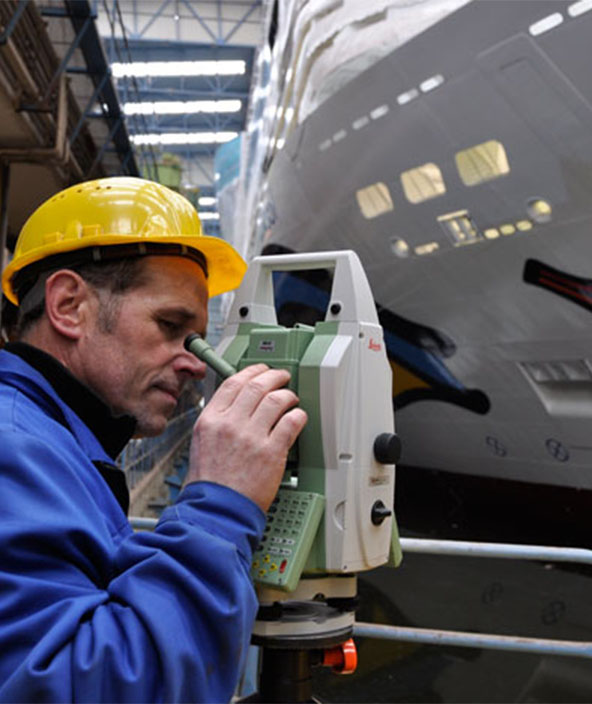Leica Absolute Tracker AT901 ensures efficiency of hydroelectric power stations
Vorarlberger Illwerke - Austria
Contact us
Vorarlberger Illwerke operates ten hydroelectric power stations in the Montafon alpine valley in Austrian state of Vorarlberg and produces valuable peak-load and regulating energy. The company regularly investigates the efficiency of its turbines so that the power of the water can be converted into electricity as efficiently as possible. The base data for these investigations are created using a laser tracker system from Leica Geosystems.
Anyone who drives the Silvretta high alpine road knows the importance of good brake ventilation. Gradients of up to 14%, one hairpin bend after another and views on to spectacular alpine landscapes are characteristic features along this 25 km long private mountain road. The owner of the road is Vorarlberger Illwerke AG, part of illwerke vkw, the largest electricity provider in Vorarlberg. The company built roads like this in the 1920s to allow access for the construction of hydroelectric stations and storage reservoirs in the higher reaches of the mountains.
Metrology for measuring large dimensions
Hydropower is an important part of the future for energy provision in Vorarlberg. And Vorarlberger Illwerke has a leading role to play in this. While it has new power stations already in the pipeline, the company is also striving to make its existing plants more efficient. To achieve this goal, Vorarlberger Illwerke relies on some highly capable metrology from Hexagon Metrology.
Ralf Laufer is a member of a 13-strong surveying team based in the Engineering Services Section at Vorarlberger Illwerke’s Schruns facility. One of Laufer’s main fields of activity is industrial metrology. His favourite piece of equipment is a Leica Absolute Tracker AT901, which, when used with the hand-held Leica T-Probe and Leica T-Scan laser scanner, forms a portable coordinate measuring machine (CMM) particularly suitable for measuring large objects. The system can be operated by one person thanks to “PowerLock” optical technology. The same technology automatically moves the laser beam, the basis of this system of measurement, towards the user.
Avoiding efficiency losses
Before new turbines are brought into operation, it is Ralf Laufer’s task to capture the exact shape of the turbine rotor for later investigations. Using the Leica T-Scan, he digitalises the whole turbine rotor to ensure that the condition of the turbine rotor can be precisely checked during future inspections. A typical turbine rotor for a Pelton turbine, like the ones used by Vorarlberger Illwerke, weighs 10 t, has a diameter of over 2 m and more than 20 blades. It is driven by water striking it at high speed – over 25,000 litres of water per second are required to move a Pelton turbine rotor of this size. After one year of operation, a new scan provides information about how the turbine rotor has deformed and where efficiency losses may be taking place. “Our objective is to detect damage and wear, and to prevent defects,” says Ralf Laufer.
When a hydroelectric station is inspected, Ralf Laufer is also on hand to digitise turbine rotors in use for many decades. The measurement results also allow conclusions to be drawn about all turbine rotors of the same type. “If one of them shows wear, it is highly probable that others will also be affected,” says Ralf Laufer. Analysis of the information supplied by the metrologists is therefore very important for the electricity generation company’s mechanical engineers.
Investigating sensitive parts
Particular attention needs to be paid to a turbine rotor’s sensitive parts, for example the discharge openings on the outer edge of the “buckets”. Vortices can occur here, reducing turbine efficiency and accelerating wear. The optimum shape of the turbine blade itself is also important. Further scope for investigation: are all the blades identical? Does the water strike the blade at the point where it is most efficient? The measurements produced using the Leica Absolute Tracker and the Leica T-Scan make this analysis much easier.
Every day counts
“When an existing power station is inspected, it’s our task to ensure that the dismantled turbines are put back exactly into their original positions. We create a network of reference points, check the compliance of the machine axes and whether flange plates and mounting holes line up with one another,” says Ralf Laufer. To do this he uses the Leica T-Probe, which can capture even the most inaccessible points with no direct line of sight to the Laser Tracker. The geographic conditions mean industrial surveying techniques are essential to these investigations. Sometimes Vorarlberger Illwerke has to use heavy-lift helicopters to transport turbines and machine parts of this size to where they perform their functions, high in the mountains. This form of transport is risky and expensive – if more than one attempt is needed, budgets and deadlines can very quickly be exceeded. Ralf Laufer: “Every day counts in the energy business.” The Leica Absolute Tracker AT901 goes along in the helicopter cargo net, providing proof that it is unaffected by difficult conditions such as high humidity and temperatures close to freezing point.
“The Tracker system is ideal for our purpose,” concludes Laufer. “Changing between scanning and probing on the same part works superbly. The Leica T-Probe has no equal. We have been using Leica Geosystems instruments for many years and have learned to appreciate their reliability. The same also applies to the quick service we receive from Hexagon Metrology Austria.”

